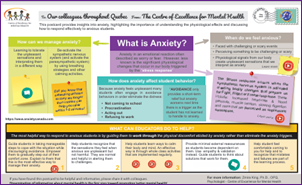What is anxiety?

For more information about anxiety and its treatment:
https://www.anxietycanada.com
https://childmind.org/topics/anxiety
https://www.cheo.on.ca/en/resources-and-support/anxiety-and-stress-management.aspx
https://www.spacetreatment.net
https://anxieties.com
https://www.youtube.com/@ADAA_Anxiety
Books on Anxiety:
For adults
Breaking free from childhood anxiety and OCD By Eli Lebowitz
Anxious Kids, Anxious parents, by Reid Wilson and Lynn Lyons
Stopping the Noise in Your Head: The New Way to Overcome Anxiety and Worry By Reid Wilson
For kids
What to do when you worry too much: a kid’s guide to overcoming anxiety by Dawn Huebner
Outsmarting worry: an older Kid’s guide to managing anxiety by Dawn Huebner
Anxious Ninja: A children's book about managing anxiety and difficult emotions by Mary Nhin
Wilma Jean the Worry Machine by Julia Cook